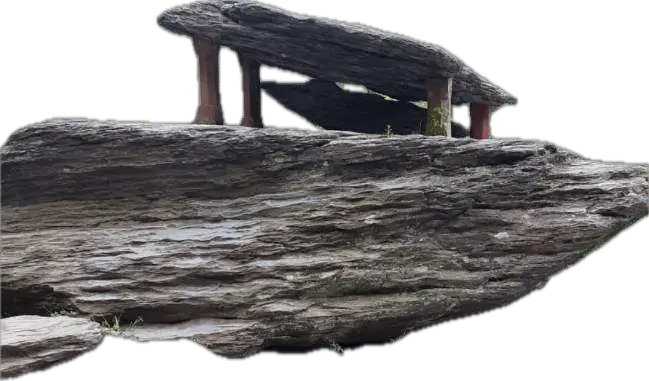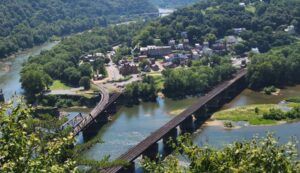For anyone who admires and appreciates the wisdom, intelligence and pride in the nation he helped found, a visit to Jefferson’s Rock in Harpers Ferry West Virginia is well worth the steep hike to get to it, the piece of the Appalachian Trial you can cover at the same time, and the beauty of the place Thomas Jefferson got on that rock to view…the confluence of the Potomac and Shenandoah rivers several hundred feet below.
Now under the jurisdiction of the National Park Service, which doesn’t seem to care much about it, the rock is actually a mass of shale rock on top of other very large masses of shale, one on top of each other.
When Thomas Jefferson was in town in 1783, long before he was President and when he was a mere 40 years old, the slab he stepped on for a better view of the surroundings was on a very narrow natural foundation. The slab was so narrow he could sway the rock back and forth with a slight push.
Weather and curiosity seekers cutting chunks from where Jefferson stood made it even thinner, so it became even more dangerous to be on or near it. Sometime in the late 1850s, the Army armory superintendent in Harpers Ferry ordered four stone pillars to be placed underneath the corners of the slab to keep it from moving, saying Jefferson Rock was “endangering the lives and properties of the villagers below.”.
Today, the slab is still there, the pillars under it are still there, and most likely daring young people still scale it to stand where Mr. Jefferson stood. However, falling off it means a swift fall straight down between treetops and hard rock before actually hitting any ground.
But it’s magnificent to see, if only to contemplate Jefferson’s admiration of natural beauty.
Jefferson Rock is along West Virginia’s portion of the Appalachian trail, a short distance further down the mountain from Harper Cemetery, the family burial grounds of the founder of this small town better known for the insurrection against the nation led by John Brown, a key reason for the onset of the Civil War.
The town is also at the precise spot where the Potomac and Shenandoah rivers meet and flow together in what Jefferson described as “perhaps one of the most stupendous scenes of Nature.”
But that wasn’t enough for this lover of nature to say. He had to describe the Blue Ridge on the mountains and the beauty of the rivers below more precisely to be sure everyone appreciated it.
So he continued: “You stand on a very high point of land. On your right comes up the Shenandoah, having ranged along the foot of the mountain a hundred miles to seek a vent. On your left approaches the Patowmac in quest of a passage also. In the moment of their junction they rush together against the mountain, rend it asunder and pass off to the sea.”
Still not enough to describe what he saw. The man who went on to become the third President wanted to let you know what it felt like for him to see this: He continued “The first glance of this scene hurries our senses into the opinion that this earth has been created in time, that the mountains were formed first, that the rivers began to flow afterwards, that in this place particularly they have been so dammed up by the Blue Ridge of mountains as to have formed an ocean which filled the whole valley; that, continuing to rise, they have at last broken over at this spot and have torn the mountain down from its summit to its base.”
The man has a way with words. He went on to write about the piles of rock, the marks of disruptions from riverbeds and how the result is so different from the forces of nature that caused it all. “It is as placid and delightful as that is wild and tremendous… , a small catch of smooth blue horizon, … inviting views, “from the riot and tumult roaring around….to the calm below.” This scene is worth a voyage across the Atlantic.”
Jefferson’s words, later written in the Notes on the State of Virginia (of which West Virginia was a part at the time) were published in 1785.
Access to Jefferson’s Rock is either down Washington St to Church street and up a trail and a few rocks to get to it, or from the Lower Town below St. Peter’s Catholic Church, up a steep flight of steps near the Civil War Museum to the steps by St. Peters and past the ruins of St. John’s Episcopal Church to the same rocks just below Jefferson’s rock.
Either way, it’s worth the walk.
While at that height, it’s only a short little hill to the family cemetery with stones dating back to the Revolution and still burials today. Many of the graves are tended, with fresh flowers or American flags, others are illegible. All the grounds are kept clean and benches invite prayer time and meditation.
A second stop to once again admire everything Jefferson described, a jaunt down all those rocky steps and a visit to the National Park Service historic sites before dinner and another walk up to the Upper Town and the Harper Valley Guest House.





